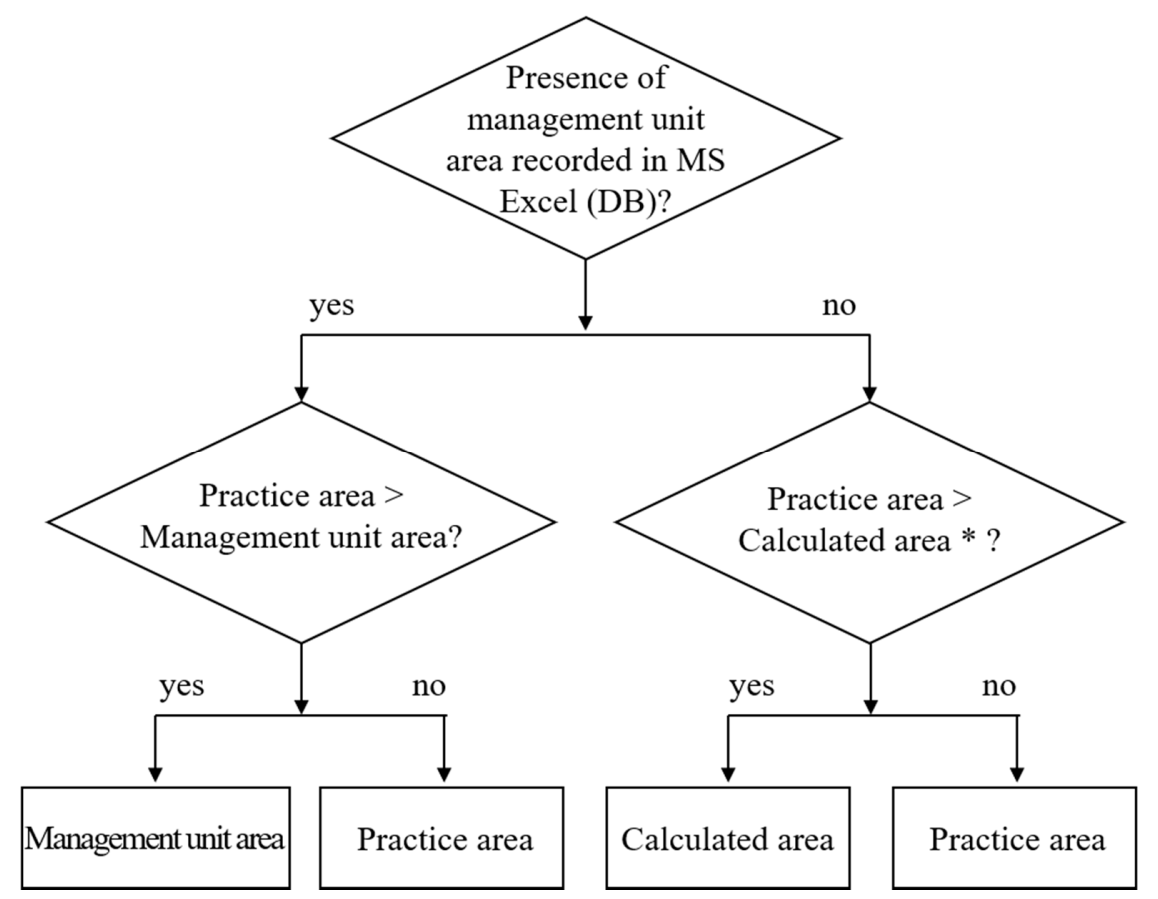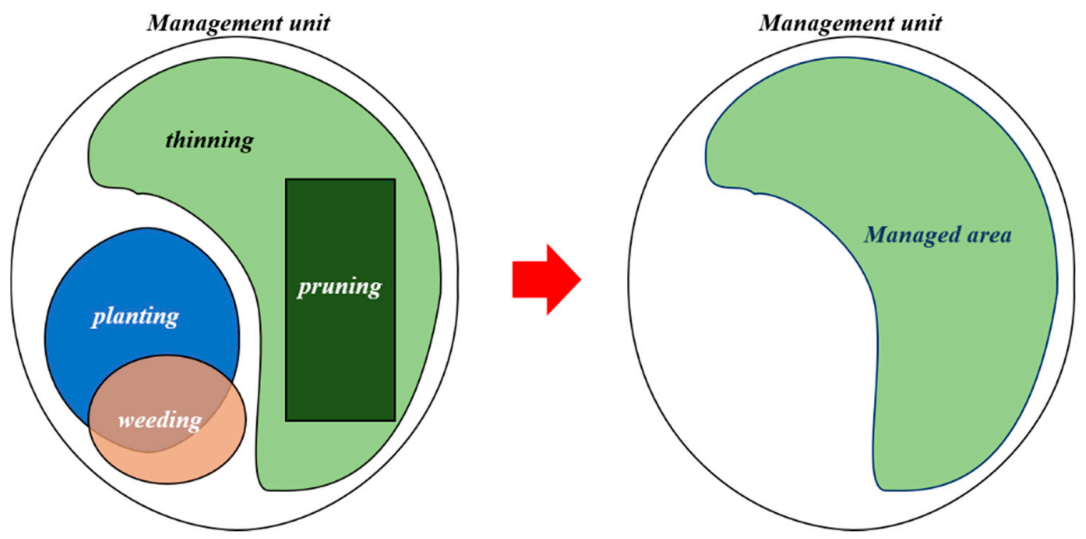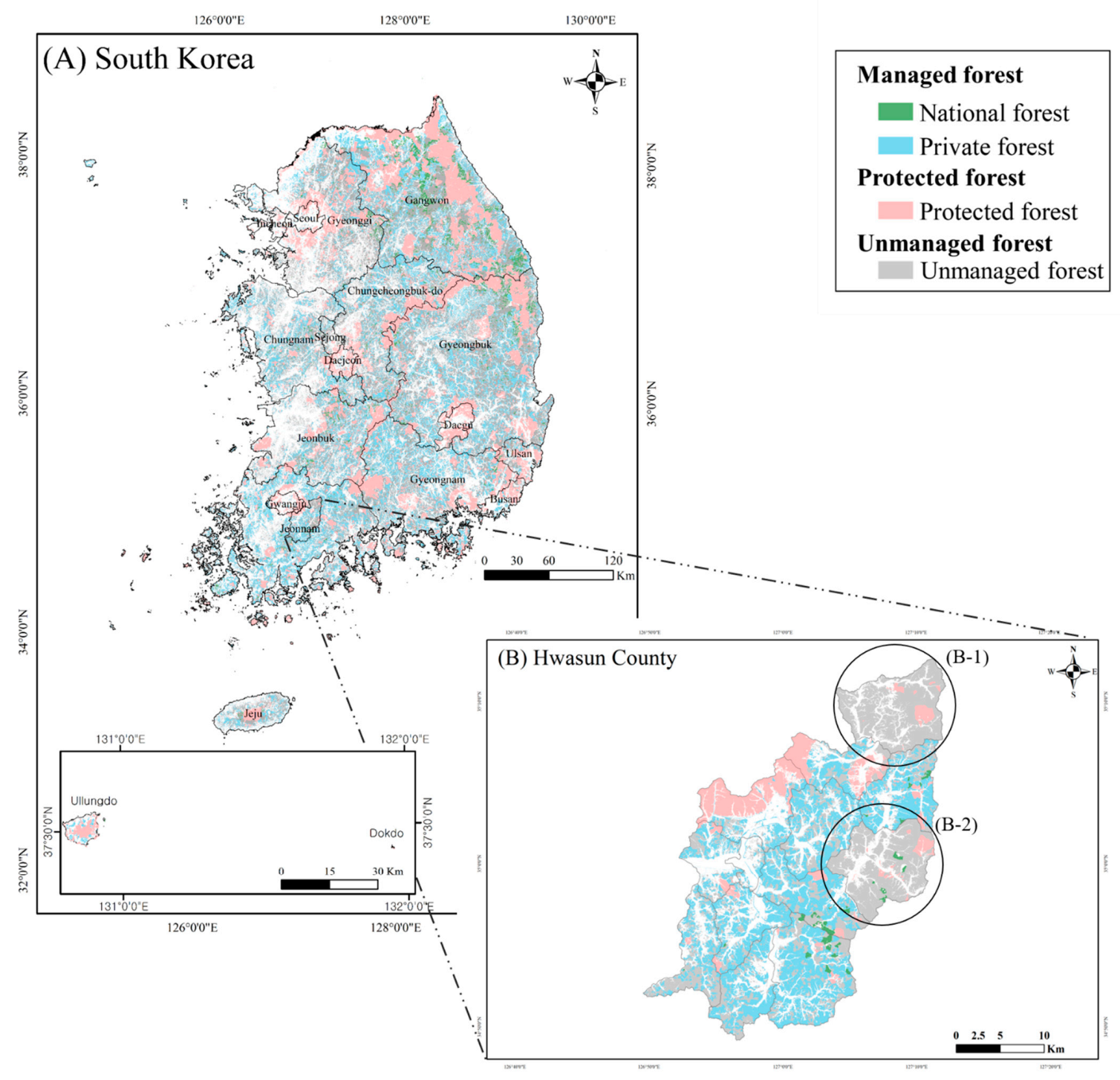Spatial and Temporal Patterns of Forest Management Activities from 1990 to 2019 to Demonstrate Additionality for Climate Change Mitigation in the Forest Sector of South Korea
Abstract
1. Introduction
2. Materials and Methods
2.1. Definition of Terms and Assumption
2.2. Estimation of FM Ratio
2.2.1. Data
2.2.2. Analysis Procedure
2.3. Characteristic Analysis of Managed and Protected Forests
3. Results and Discussion
3.1. Estimation of Forest Management Ratio
3.2. Characteristics of Forest Management Areas
4. Conclusions
Author Contributions
Funding
Data Availability Statement
Acknowledgments
Conflicts of Interest
Appendix A
| Protected Forest Properties * | Relevant Act |
|---|---|
| Natural recreation forests | Forestry Culture and Recreation Act |
| Forestland of temple forests | Mountainous Districts Management Act |
| Restricted areas for conversion and temporary use | Mountainous Districts Management Act |
| Mountainous districts in Special protection and wildlife protection for wildlife prescribed | Wildlife protection and management Act |
| Mountainous districts in park areas | Natural Parks Act |
| Mountainous districts in protective zones for the preservation of cultural heritage assets | Cultural Heritage Protection Act |
| Mountainous districts in water-source protection areas | The Water Supply and Waterworks Installation Act |
| Mountainous districts in development restriction zones | The Special Measures for Designation and Management of Development Restriction Zones Act |
| Mountainous districts in green areas prescribed by Presidential Decree | The National Land Planning and Utilization Act |
| Mountainous districts in ecological and scenery conservation areas | The Natural Environment Conservation Act |
| Mountainous districts in wetlands protection areas | The Wetlands Conservation Act |
| Mountainous districts in specified islands | The Special Act on the Preservation of the Ecosystems in Island including Dokdo |
| Mountainous districts in Baekdu-daegan Protection Areas | The Baekdu-daegan Protection Act |
| Mountainous districts in forest protection areas prescribed | The Forest Protection Act |
| Other mountainous districts necessary for promoting public interest functions | Presidential Decree |
References
- Jiao, Y.; Hu, H.Q. Carbon storage and its dynamics of forest vegetations in Heilongjiang Province. Chin. J. Appl. Ecol. 2005, 16, 2248–2252. Available online: http://europepmc.org/abstract/med/16515166 (accessed on 8 February 2021).
- Lee, S.; Lee, S.; Shin, J.; Yim, J.; Kang, J. Assessing the Carbon Storage of Soil and Litter from National Forest Inventory Data in South Korea. Forests 2020, 11, 1318. [Google Scholar] [CrossRef]
- Pan, Y.; Birdsey, R.A.; Fang, J.; Houghton, R.; Kauppi, P.E.; Kurz, W.A.; Phillips, O.L.; Shvidenko, A.; Lewis, S.L.; Canadell, J.G.; et al. A Large and Persistent Carbon Sink in the World’s Forests. Science 2011, 333, 988–993. [Google Scholar] [CrossRef] [PubMed]
- KOFPI (Korea Forestry Promotion Institute). Korea Forest Resources by Numbers; KOFPI: Seoul, Korea, 2017; p. 13. [Google Scholar]
- Yim, J.S.; Kim, R.H.; Lee, S.J.; Son, Y.M. Land-use Change Assessment by Permanent Sample Plots in National Forest Inventory. J. Clim. Chang. Res. 2015, 6, 33–40, (In Korean with English Abstract). [Google Scholar] [CrossRef]
- UNFCCC (The United Nations Framework Convention on Climate Change). Report of the Conference of the Parties Serving as the Meeting of the Parties to the Kyoto Protocol on Its Seventh Session, Held in Durban from 28 November to 11 December 2011. Available online: https://unfccc.int/resource/docs/2011/cmp7/ (accessed on 8 February 2021).
- UNFCCC. Report of the Conference of the Parties Serving as the Meething of the Parties to the Paris Agreement on the Third Part of Its First Session, Held in Katowice from 2 to 15 December 2018. Available online: https://unfccc.int/sites/default/files/resource/ (accessed on 8 February 2021).
- IPCC (Intergovernmental Panel on Climate Change). IPCC Guidelines for National Greenhouse Gas Inventory; IPCC/IGES: Hayama, Japan, 2006. [Google Scholar]
- Bradford, J.B.; Kastendick, D.N. Age-related patterns of forest complexity and carbon storage in pine and aspen–birch ecosystems of Northern Minnesota, USA. Can. J. Res. 2010, 40, 401–409. [Google Scholar] [CrossRef]
- An, H.J.; Seok, H.D.; Lee, S.M.; Choi, J.Y. Forest management practice for enhancing carbon sequestration in national forests of Korea. For. Sci. Technol. 2019, 15, 80–91. [Google Scholar] [CrossRef]
- Perez-Garcia, J.; Lippke, B.; Comnick, J.; Manriquez, C. An assessment of carbon pools, storage, and wood products market substitution using life-cycle analysis results. Wood Fiber. Sci. 2007, 37, 140–148. [Google Scholar]
- Fahey, T.J.; Woodbury, P.B.; Battles, J.J.; Goodale, C.L.; Hamburg, S.P.; Ollinger, S.V.; Woodallp, C.W. Forest carbon storage: Ecology, management, and policy. Front. Ecol. Environ. 2010, 8, 245–252. [Google Scholar] [CrossRef]
- Lippke, B.; Oneil, E.; Harrison, R.; Skog, K.; Gustavsson, L.; Sathre, R. Life cycle impacts of forest management and wood utilization on carbon mitigation: Knowns and unknowns. Carbon Manag. 2011, 2, 303–333. [Google Scholar] [CrossRef]
- UNFCCC. Synthesis Report of the Technical Assessments of the Forest Management Reference Level Submissions. Available online: https://unfccc.int/sites/default/files/resource/docs/2011/ (accessed on 8 February 2021).
- IPCC. 2013 Revised Supplementary Methods and Good Practice Guidance Arising from the Kyoto Protocol; IPCC/IGES: Hayama, Japan, 2014. [Google Scholar]
- UNFCCC. Japan’s Fourth Biennial Report. Available online: https://www4.unfccc.int/sites/SubmissionsStaging/NationalReports/Documents/ (accessed on 8 February 2021).
- UNFCCC. Submission by the Republic of Korea: Intended Nationally Determined Contribution. Available online: https://www4.unfccc.int/sites/ndcstaging/PublishedDocuments/ (accessed on 8 February 2021).
- Korea Forest Service (KFS). 2021 Annual Plan to Implement a Comprehensive Plan for Carbon Sink Enhancement; KFS: Daejeon, Korea, 2020; p. 21. (In Korean)
- GIR (Greenhouse Gas Inventory and Research Center). National Greenhouse Gas Inventory Report of Korea; GIR: Chungcheongbuk-do, Korea, 2020; p. 438. [Google Scholar]
- Han, H.; Shin, J.H.; Kim, Y.H.; Bae, J.S. Estimation of national-level carbon absorption considering long-term changes in forests. In Proceedings of the International symposium for 60th Anniversary of Korean Society of Forest Science “Globalization of Korean Forests Science Research”, Kangwon, Korea, 30 November 2020. [Google Scholar]
- KFS. Statistical Yearbook of Forestry; KFS: Daejeon, Korea, 2020; p. 449.
- UNFCCC. Report of the Technical Assessment of the Forest Management Reference Level Submission of Japan Submitted in 2011; UNFCCC: Bonn, Germany, 2011. [Google Scholar]
- Kim, K.M.; Roh, Y.H.; Kim, E.S. Comparison of Three Kinds of Methods on Estimation of Forest Carbon Stocks Distribution Using National Forest Inventory DB and Forest Type Map. J. Korean Assoc. Geogr. Inf. Stud. 2014, 17, 69–85. [Google Scholar] [CrossRef]
- NIES (National Institute for Environmental Studies). National Greenhouse Gas Inventory Report of Japan; NIES: Ibaraki, Japan, 2019. [Google Scholar]
- Kim, H.H.; Kang, H.D.; Kim, R.H.; Kim, C.M.; Koh, K.C.; Lee, K.H. Estimation of forest management ratio under article 3.4 of the Kyoto Protocol: A case study on the Chungcheongbukdo. J. Kor. For. Soc. 2013, 102, 608–616. [Google Scholar] [CrossRef][Green Version]
- Seo, Y.O.; Lumbres, R.I.C.; Jung, S.C.; Won, H.K.; Lee, Y.J. Application of national forest inventory data to estimate management ratios for private forests in Chungnam province. J. Agirc. Life Sci. 2015, 49, 31–37. [Google Scholar] [CrossRef]
- Ham, B.Y.; Song, C.H.; Park, E.B.; Choi, S.E.; Lee, W.K. Development of Forest Activity Data and Forest Management Rate for National Greenhouse Gas Inventory in the Forest Sector. J. Clim. Chang. Res. 2020, 11, 53–63. [Google Scholar] [CrossRef]
- FAO (Food and Agriculture Organization of the United Nations). Asia-Pacific Forestry Commission: Development of National-Level Criteria and Indicators for the Sustainable Management of Dry Forests of Asia: Background Papers; FAO: Rome, Italy, 2000; p. 7. [Google Scholar]
- ESRI (Environmental Systems Research Institute). ArcGis Desktop: Release 10; ESRI: Redlends, CA, USA, 2011. [Google Scholar]
- Nakajima, T.; Takuya, H.; Amano, M. Developing Methods for Estimating Forest Areas under Article 3.4 of the Kyoto Protocol: A Case Study on Private Lands in Gifu Prefecture, Japan. J. Jpn. For. Soc. 2006, 88, 181–186. [Google Scholar] [CrossRef][Green Version]
- Hiroshima, T.; Nakajima, T. Estimation of Sequestered Carbon in Article-3.4 Private Planted Forests in the First Commitment Period in Japan. Forestry Agency, Japan. J. For. Res. 2006, 11, 427–437. [Google Scholar] [CrossRef]
- National Law Information Center. Creation and Management of Forest Resources Act (Article 36 Permission, Reporting, ect. of Felling Standing Timber, etc.). Available online: https://elaw.klri.re.kr/kor_service/ (accessed on 8 February 2021).
- Cha, D.S.; Ji, B.Y.; Kim, K.M.; Choi, I.H. Investigation and effect analysis for silvicultural activities with forest road establishment. J. Korean For. Soc. 1998, 87, 239–252. (In Korean) [Google Scholar]
- Norihiko, S. An analysis of forestry operation’s intensity from the viewpoint of accessibility. J. Jpan. For. Soc. 1994, 76, 218–223. (In Japanese) [Google Scholar]
- Hwang, J.S.; Ji, B.Y.; Jung, D.H.; Cho, M.J. Effect of Forest Road Network on Accessibility and Cost Reduction for Forest Operations (I) Silvicultural Operations. J. Korean For. Soc. 2015, 104, 615–621. [Google Scholar] [CrossRef]
- KFS. Mountainous Districts Management Act–Article 4–Classification of Mountainous Districts; KFS: Daejeon, Korea, 2020.



| Category | Database System (Period) | Data Type | |
|---|---|---|---|
| Managed forest | National forest | NFMIS * (1990–2012) | MS Excel |
| IMSFR ** (2013–2019) | MS Excel, GIS Shp file | ||
| Private forest | PFMIS *** (2003–2019) | MS Excel | |
| Protected forest | FLIS **** (2008–2020) | GIS Shp file | |
| Year | Managed Forest | Protected Forest (1000 ha) | |||
|---|---|---|---|---|---|
| National Forest | Private Forest | ||||
| CN * (n) | MA ** (1000 ha) | CN * (n) | MA ** (1000 ha) | ||
| 2008 | 7764 | 95 | 315,552 | 752 | 1702 |
| 2009 | 9057 | 115 | 391,865 | 924 | 1704 |
| 2010 | 10,050 | 129 | 460,132 | 1066 | 1680 |
| 2011 | 11,047 | 143 | 534,406 | 1203 | 1667 |
| 2012 | 11,950 | 156 | 607,834 | 1355 | 1659 |
| 2013 | 11,950 | 156 | 662,290 | 1481 | 1646 |
| 2014 | 11,963 | 157 | 709,496 | 1568 | 1640 |
| 2015 | 13,266 | 173 | 749,299 | 1643 | 1637 |
| 2016 | 14,195 | 185 | 790,157 | 1704 | 1625 |
| 2017 | 14,888 | 195 | 834,010 | 1764 | 1628 |
| 2018 | 15,582 | 201 | 893,253 | 1806 | 1623 |
| 2019 | 16,006 | 206 | 927,779 | 1840 | 1675 |
| Year | Forest Management Area (1000 ha) | Total Forest Area ** (1000 ha) | FM Ratio *** (%) | |||
|---|---|---|---|---|---|---|
| Managed Forest * | Protected Forest | Total | ||||
| National Forest | Private Forest | |||||
| 2008 | 55 | 639 | 1702 | 2395 | 6375 | 37.6 |
| 2009 | 66 | 784 | 1704 | 2553 | 6370 | 40.1 |
| 2010 | 75 | 908 | 1680 | 2663 | 6369 | 41.8 |
| 2011 | 82 | 1022 | 1667 | 2771 | 6348 | 43.7 |
| 2012 | 89 | 1152 | 1659 | 2901 | 6340 | 45.8 |
| 2013 | 89 | 1260 | 1646 | 2995 | 6339 | 47.2 |
| 2014 | 89 | 1337 | 1640 | 3066 | 6342 | 48.3 |
| 2015 | 100 | 1400 | 1637 | 3137 | 6335 | 49.5 |
| 2016 | 109 | 1455 | 1625 | 3188 | 6326 | 50.4 |
| 2017 | 116 | 1508 | 1628 | 3252 | 6318 | 51.5 |
| 2018 | 121 | 1546 | 1623 | 3290 | 6306 | 52.2 |
| 2019 | 127 | 1563 | 1675 | 3365 | 6299 | 53.4 |
| Average increase/decrease (1000 ha, %) | 7 | 84 | −2 | 88 | −7 | 1.4 |
| Provinces | Forest Management Area (1000 ha) | FM Ratio (%) | |||||
|---|---|---|---|---|---|---|---|
| Forest Area | National Forest | Private Forest | Protected Forest * | Total | |||
| Seoul | 15 | 0.002 | 1 | 11 | (72) | 12 | 80 |
| Busan | 35 | 0.074 | 7 | 20 | (59) | 27 | 79 |
| Daegu | 48 | - | 1 | 42 | (86) | 43 | 88 |
| Incheon | 39 | 0.011 | 12 | 7 | (19) | 19 | 48 |
| Gwangju | 19 | - | 1 | 16 | (83) | 17 | 91 |
| Daejeon | 30 | 0.183 | 3 | 22 | (74) | 25 | 85 |
| Ulsan | 68 | 0.081 | 8 | 33 | (48) | 41 | 60 |
| Sejong | 25 | 0.159 | 3 | 4 | (17) | 7 | 29 |
| Gyeonggi | 512 | 6.157 | 58 | 152 | (30) | 216 | 42 |
| Gangwon | 1368 | 67.265 | 242 | 457 | (33) | 767 | 56 |
| Chunbuk | 488 | 6.646 | 111 | 131 | (27) | 249 | 51 |
| Chunnam | 404 | 3.892 | 140 | 51 | (13) | 195 | 48 |
| Jeonbuk | 441 | 7.389 | 103 | 127 | (29) | 237 | 54 |
| Jeonnam | 687 | 5.127 | 300 | 132 | (19) | 437 | 64 |
| Gyeongbuk | 1334 | 25.736 | 335 | 273 | (20) | 634 | 48 |
| Gyeongnam | 699 | 3.583 | 221 | 175 | (25) | 399 | 57 |
| Jeju | 87 | 0.516 | 16 | 22 | (25) | 38 | 44 |
| Sum | 6299 | 126.8 | 1563 | 1675 | (27) | 3365 | 53 |
| Category | Elevation (m) | Slope (°) | No. of Cases | |||
|---|---|---|---|---|---|---|
| Mean | Std. | Mean | Std. | |||
| Managed forest | National | 365 | 145.7 | 20 | 8.2 | 4,018,334 |
| Private | 229 | 157.4 | 15 | 9.2 | 27,918,371 | |
| Protected forest | 326 | 204.6 | 18 | 8.6 | 18,536,911 | |
| Managed Forest ** | Protected Forest *** | ||||||||
|---|---|---|---|---|---|---|---|---|---|
| Plantation | Natural | Total | Plantation | Natural | Total | ||||
| Age class * | I | 135.50 | 6.24 | 141.74 | (8%) | 21.29 | 1.72 | 23.00 | (1%) |
| II | 54.24 | 22.10 | 76.35 | (5%) | 11.49 | 10.28 | 21.78 | (1%) | |
| III | 64.38 | 163.59 | 227.96 | (13%) | 29.25 | 124.89 | 154.14 | (10%) | |
| IV | 118.24 | 664.80 | 783.04 | (46%) | 89.37 | 663.11 | 752.48 | (47%) | |
| V | 24.94 | 342.43 | 367.37 | (22%) | 26.85 | 471.31 | 498.16 | (31%) | |
| VI | 0.93 | 32.37 | 33.30 | (2%) | 1.19 | 93.18 | 94.38 | (6%) | |
| VII | 0.04 | 1.37 | 1.41 | (0%) | 0.22 | 8.40 | 8.62 | (1%) | |
| VIII | 0.01 | 1.06 | 1.07 | (0%) | 0.19 | 1.89 | 2.08 | (0%) | |
| IX | 0.02 | 0.06 | 0.09 | (0%) | 0.05 | 1.03 | 1.08 | (0%) | |
| Unstocked **** | - | - | 57.67 | (3%) | - | - | 35.13 | (2%) | |
| Sum | 398.30 | 1234.02 | 1690.00 | (100%) | 179.90 | 1375.81 | 1590.84 | (100%) | |
| Percentile (%) | Distance from Road (m) | |
|---|---|---|
| National Forest | Private Forest | |
| 70 | 234 | 93 |
| 80 | 328 | 137 |
| 90 | 478 | 214 |
| 100 | 2338 | 3080 |
Publisher’s Note: MDPI stays neutral with regard to jurisdictional claims in published maps and institutional affiliations. |
© 2021 by the authors. Licensee MDPI, Basel, Switzerland. This article is an open access article distributed under the terms and conditions of the Creative Commons Attribution (CC BY) license (https://creativecommons.org/licenses/by/4.0/).
Share and Cite
Lee, S.; Lee, S.; Han, H.; You, J.; Yim, J.; Bae, J.S. Spatial and Temporal Patterns of Forest Management Activities from 1990 to 2019 to Demonstrate Additionality for Climate Change Mitigation in the Forest Sector of South Korea. Forests 2021, 12, 1003. https://doi.org/10.3390/f12081003
Lee S, Lee S, Han H, You J, Yim J, Bae JS. Spatial and Temporal Patterns of Forest Management Activities from 1990 to 2019 to Demonstrate Additionality for Climate Change Mitigation in the Forest Sector of South Korea. Forests. 2021; 12(8):1003. https://doi.org/10.3390/f12081003
Chicago/Turabian StyleLee, Seunghyun, Sunjeoung Lee, Hee Han, Joungwon You, Jongsu Yim, and Jae Soo Bae. 2021. "Spatial and Temporal Patterns of Forest Management Activities from 1990 to 2019 to Demonstrate Additionality for Climate Change Mitigation in the Forest Sector of South Korea" Forests 12, no. 8: 1003. https://doi.org/10.3390/f12081003
APA StyleLee, S., Lee, S., Han, H., You, J., Yim, J., & Bae, J. S. (2021). Spatial and Temporal Patterns of Forest Management Activities from 1990 to 2019 to Demonstrate Additionality for Climate Change Mitigation in the Forest Sector of South Korea. Forests, 12(8), 1003. https://doi.org/10.3390/f12081003






